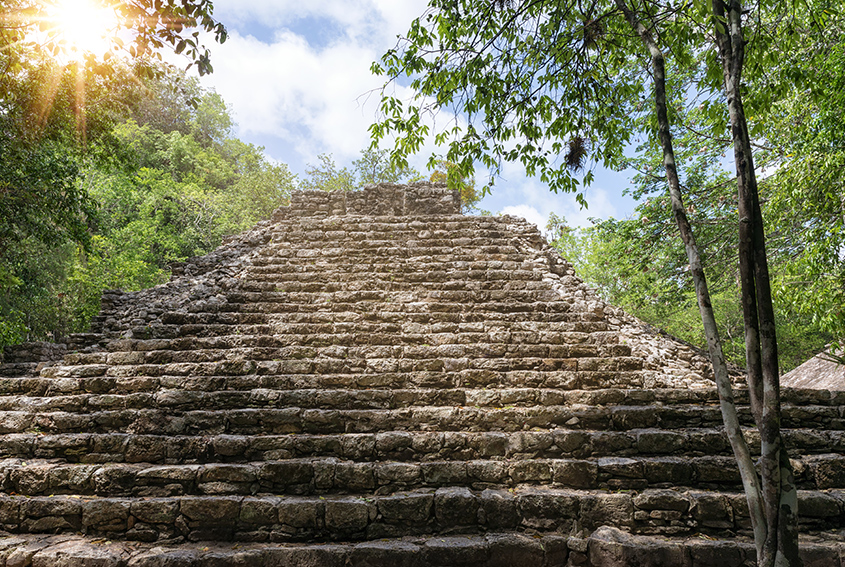From the jungle to the sea, the Riviera Maya’s archaeological sites are full of contrasts. Here are three that you could visit in one day, but we recommend them as experiences to be enjoyed slowly, at your own pace.

Coba
Head inland to the ancient city of Coba (25 miles/41 km from the coast), one of the Maya World’s largest archaeological sites.
Coba means “waters ruffled by the wind” in Maya and the pyramids and temples at this jungle site are clustered around four shallow lakes. The city reached its peak during the Mayan Classic period, A.D. 250-900, when it was an important trade center. Archaeologists believe that it may have had links with Tikal in Guatemala. The most recent discovery at the site is the identification of the ancient dynasty that dominated Coba and the names of 14 rulers through the study of hieroglyphic inscriptions carved on stelae and wall tablets.
The principal buildings or groups at Coba are Nohoch Mul, at 42 meters, the tallest pyramid in the northern Yucatán, the Cobá group, La Iglesia (another pyramid), Las Pinturas, the Ball Court, Xaibe and the Macanxoc group which has nine circular altars and eight stelae.
Cobá is famous for the sacbes or Mayan roads that radiate from the heart of the city. The longest sacbe in the Maya World links the city with the site of Yaxuná, near Chichén Itzá and is 101 km long.
During your walks along jungle trails past temples that still lie under vines and foliage, you’ll see some of the creatures that make their home in Coba. They include huge iridescent blue morph butterflies, turquoise-browed motmots, parrots and shy agoutis, terrier-sized rodents that scuttle through the undergrowth.

Tulum
Crowning a cliff overlooking the Caribbean, Tulum is one of the Maya World’s most spectacular sites. “Tulum” means “wall” in Maya, a reference to the sturdy stone barrier that protects it on three sides, the fourth being the sea, but in ancient times the city was known as Zama or Dawn.
An inscription on a stela or standing stone found at the site reveals that Tulum was inhabited as far back as A.D. 564 although it reached its peak during the Post-Classic period (1250–1521) as a port on the sea and land trade routes.
The principal building at Tulum is a temple known as El Castillo; other important groupings are the Temple of the Descending God, Temple of the Frescos and the House of the Columns.
Spend a few minutes taking in the breathtaking views of the temples, the bay at the foot of the cliff that was once used by Maya seafarers, and the coast north and south.

Muyil
About 20 minutes to the south of Tulum via Highway 307, the archaeological site of Muyil, also known as Chunyaxche, is on the shores of a lagoon in the Sian Ka’an Biosphere Reserve. Once a Maya trade center, it received goods brought by canoe from the Caribbean and shipped them overland to other cities in the Yucatan.
Combine a Muyil visit with an unforgettable boat trip through the Sian Ka’an wetlands to see birds, crocodiles and other wild creatures.
Your Concierge can help you organize trips to the archaeological sites in the Riviera Maya and Yucatan.





Leave a Reply
Want to join the discussion?Feel free to contribute!